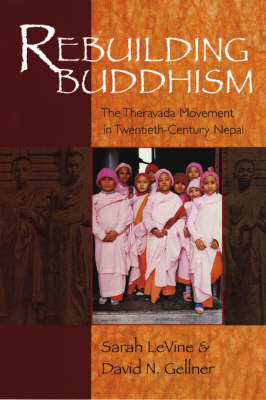
Rebuilding Buddhism
The Theravada Movement in Twentieth-Century Nepal
Seiten
2005
Harvard University Press (Verlag)
978-0-674-01908-9 (ISBN)
Harvard University Press (Verlag)
978-0-674-01908-9 (ISBN)
- Titel ist leider vergriffen;
keine Neuauflage - Artikel merken
Describes in detail the experiences and achievements of Nepalis who have adopted Theravada Buddhism. This form of Buddhism was introduced into Nepal from Burma and Sri Lanka in the 1930s, and its adherents have struggled for recognition and acceptance ever since.
Rebuilding Buddhism describes in evocative detail the experiences and achievements of Nepalis who have adopted Theravada Buddhism. This form of Buddhism was introduced into Nepal from Burma and Sri Lanka in the 1930s, and its adherents have struggled for recognition and acceptance ever since. With its focus on the austere figure of the monk and the biography of the historical Buddha, and more recently with its emphasis on individualising meditation and on gender equality, Theravada Buddhism contrasts sharply with the highly ritualised Tantric Buddhism traditionally practiced in the Kathmandu Valley. Based on extensive fieldwork, interviews and historical reconstruction, the book provides a rich portrait of the different ways of being a Nepali Buddhist over the past 70 years. At the same time it explores the impact of the Theravada movement and what its gradual success has meant for Buddhism, for society, and for men and women in Nepal.
Rebuilding Buddhism describes in evocative detail the experiences and achievements of Nepalis who have adopted Theravada Buddhism. This form of Buddhism was introduced into Nepal from Burma and Sri Lanka in the 1930s, and its adherents have struggled for recognition and acceptance ever since. With its focus on the austere figure of the monk and the biography of the historical Buddha, and more recently with its emphasis on individualising meditation and on gender equality, Theravada Buddhism contrasts sharply with the highly ritualised Tantric Buddhism traditionally practiced in the Kathmandu Valley. Based on extensive fieldwork, interviews and historical reconstruction, the book provides a rich portrait of the different ways of being a Nepali Buddhist over the past 70 years. At the same time it explores the impact of the Theravada movement and what its gradual success has meant for Buddhism, for society, and for men and women in Nepal.
Sarah LeVine is Associate in Sanskrit and Indian Studies, Harvard University. David N. Gellner is Lecturer in the Anthropology of South Asia, University of Oxford.
| Erscheint lt. Verlag | 2.12.2005 |
|---|---|
| Zusatzinfo | 27 halftones, 2 maps, 5 tables, 1 chart |
| Verlagsort | Cambridge, Mass |
| Sprache | englisch |
| Maße | 155 x 235 mm |
| Gewicht | 704 g |
| Themenwelt | Geisteswissenschaften ► Religion / Theologie ► Buddhismus |
| ISBN-10 | 0-674-01908-3 / 0674019083 |
| ISBN-13 | 978-0-674-01908-9 / 9780674019089 |
| Zustand | Neuware |
| Haben Sie eine Frage zum Produkt? |
Mehr entdecken
aus dem Bereich
aus dem Bereich
Philosophische Betrachtungen
Buch | Softcover (2024)
Aufbau TB (Verlag)
CHF 20,95
Unterweisungen in Zen-Meditation
Buch | Hardcover (2024)
Arkana (Verlag)
CHF 29,90


